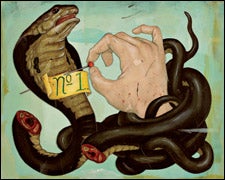If you count insects, then mosquitoes are the most prolific killers, transmitting diseases that take out at least two million a year. Our own kind is second: In recent decades, we've offed an average of one million of ourselves annually. But if you're talking claws-out, fur-flying, fangs-bared, When Animals Attack wild critters, snakes are by far the deadliest. Cobras, mambas, carpet vipers, and their slithering brethren send some 50,000 to 125,000 of us to our graves every year. After that, the body count drops precipitously. Crocodiles chomp roughly 1,000 souls annually, and tigers take out around 700. Sharks, alligators, and bears dispatch us only in the single to low double digits. Then there's that big, brown-eyed attacker you're likely not worrying about: moose, which, according to one study, kill about 11 people a year. “They can kick in all four directions,” warns Rick Sinnott, a biologist with the Alaska Department of Fish and Game, “and move like Muhammad Ali.”
Jared Eno, Washington, D.C.
You betcha. In fact, according to the Minnesota Department of Natural Resources, the state has 11,842 lakes of at least ten acres. That sounds like a lot until you learn that Alaska boasts an astounding 3.5 million lakes, defined there as anything larger than 20 acres. Downsize your definition to a quarter of an acre or larger, as Miami University of Ohio geographer Bill Renwick did for a 2002 satellite-photo survey, and Minnesota becomes the Land of At Least 100,000 Lakes. Yet by this standard, Minnesota is just seventh in the lower 48, behind dust-bowlers like Oklahoma and even dry-as-toast Texas, which (yee-haw!) tops the list with some 270,000 watering holes. Of course, many are algae-smeared cattle wallows dug by farmers. “There's a qualitative difference between them and the deep, clear lakes in Minnesota,” says Renwick. “Stand in a knee-high cow pond and you might not see your toes.”
What is muscle memory?
John Gruszynski, Madison, Wisconsin
The Rock may talk to his pecs like they're sentient beings, but muscles just flex. “Muscle memory” is a sporty phrase for a process that takes place entirely in the noggin. When you first try an Eskimo roll or the “Freebird” guitar solo, the sequence is worked out in your prefrontal cortex. Extensive repetition downloads the motions to the motor cortex, basal ganglia, or cerebellum, the brain regions that control unconscious and automatic actions, enabling you to pull a triple salchow at the drop of a sequined hat years after your last Ice Capade. Still, as University of Virginia psychology professor Daniel T. Willingham points out, “Advanced motor skills require more than knowing how to direct your muscles.” Perception, decision making, and other of-the-moment cognitive processes are also crucial. The key is practicing until the moves feel automaticwhich can take longer than you think: A study of Cuban cigar rollers found that, even after three million stogies, they were still improving.


